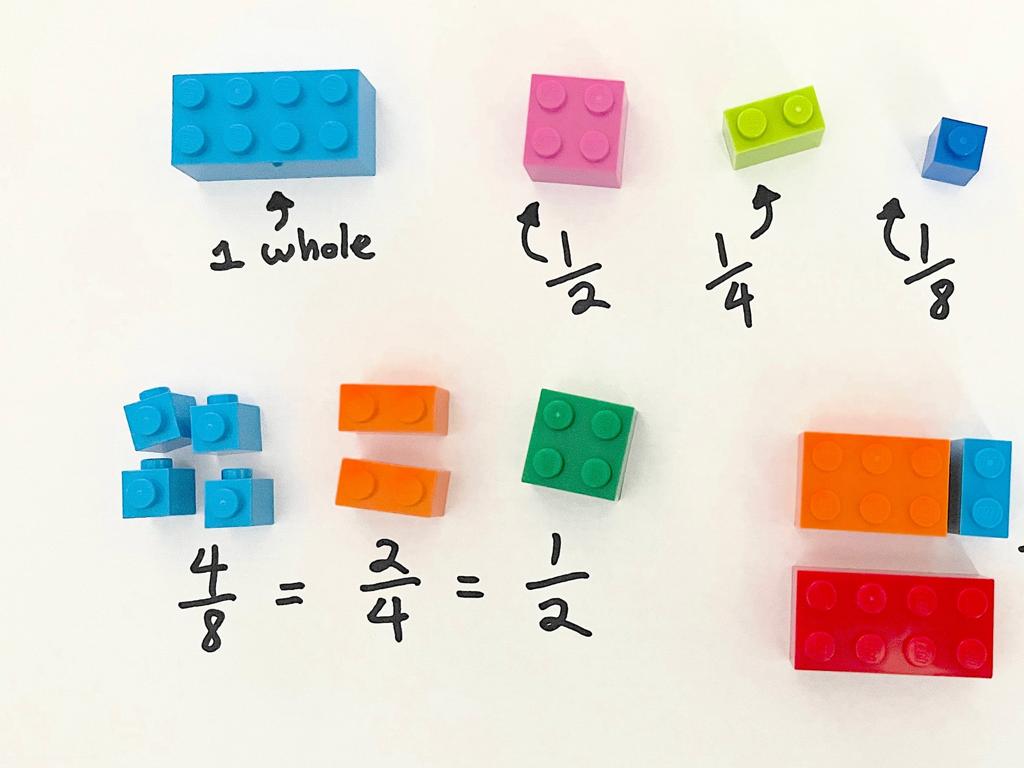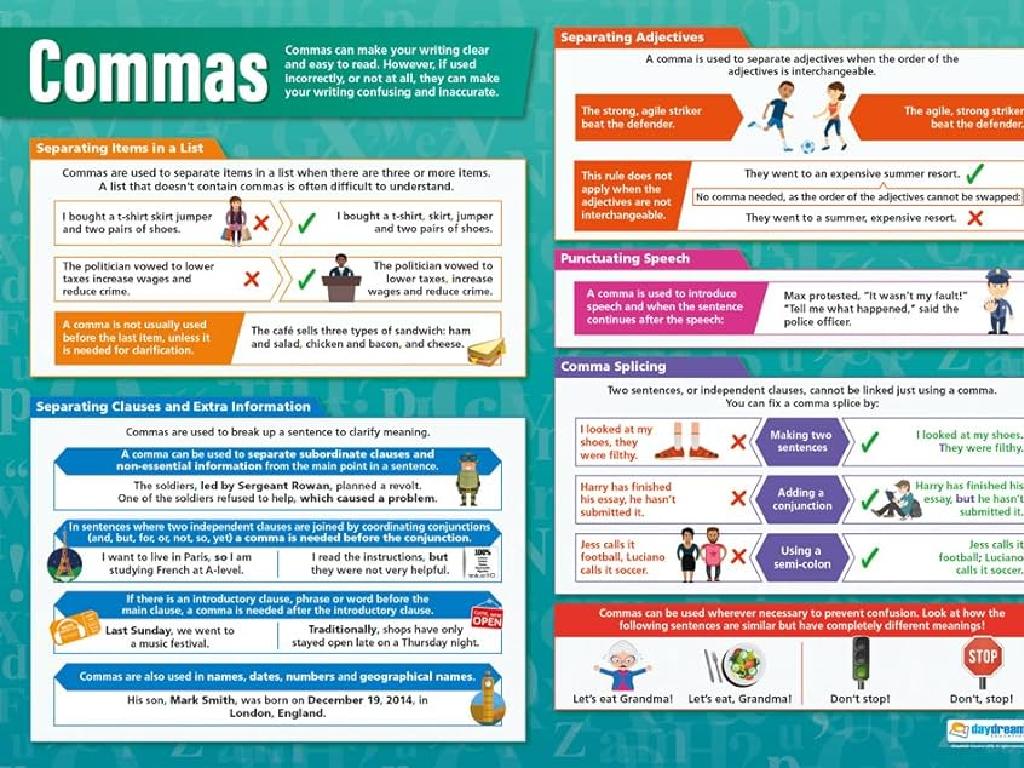Write Numbers In Words
Subject: Math
Grade: Fifth grade
Topic: Whole Numbers And Place Value
Please LOG IN to download the presentation. Access is available to registered users only.
View More Content
Introduction to Whole Numbers
– Understanding whole numbers
– Whole numbers are all positive numbers including zero, without fractions or decimals.
– Defining whole numbers
– Whole numbers include 0, 1, 2, 3, and so on.
– Exploring place value
– Place value determines the value of a digit based on its position.
– Writing numbers in words
– Practice: Write 132 as ‘one hundred thirty-two’.
|
This slide introduces the concept of whole numbers and place value, which are fundamental in understanding how to write numbers in words. Begin by explaining that whole numbers are the basic counting numbers starting from zero and that they do not include fractions or decimals. Emphasize the importance of place value in determining the value of each digit in a number. For example, in the number 132, the ‘1’ is in the hundreds place, the ‘3’ is in the tens place, and the ‘2’ is in the ones place. Encourage students to practice writing numbers in words, starting with simple numbers and gradually moving to larger ones. Provide additional examples and exercises to reinforce the concept.
Understanding Place Value
– Learn place value positions
– Ones, tens, hundreds, and more
– Value of each position
– Each digit’s value is based on its position
– Place value chart examples
– See how 345 is 3 hundreds, 4 tens, and 5 ones
– Writing numbers in words
– Practice: Write ‘345’ as ‘three hundred forty-five’
|
This slide introduces students to the concept of place value, which is fundamental in understanding how to write numbers in words. Start by explaining each place value position, from ones to hundreds and beyond, using a chart. Emphasize how the position of a digit within a number determines its value. Provide clear examples using a place value chart to illustrate how each digit contributes to the overall number. Finally, guide students through the process of converting numbers from their numerical form into written words, reinforcing the connection between place value and number spelling. Encourage practice with various numbers to build confidence.
Writing Numbers in Words
– Learn rules for number words
– Numbers have unique word forms
– Break down numbers into parts
– Separate into units, tens, hundreds
– Use hyphens correctly
– Hyphens join tens and ones places
– Practice with examples
– Write ‘twenty-five’ not ‘twenty five’
|
This slide introduces the basic rules for writing numbers in words, which is a key skill in understanding place value and number sense. Start by explaining that each number has a corresponding word form and that there are specific rules for writing these out, such as spelling out small numbers and using numerals for larger ones. Show how to break down larger numbers into their component parts (units, tens, hundreds, etc.) to make them easier to write in word form. Clarify the use of hyphens when writing two-word numbers from twenty-one to ninety-nine. Provide several examples for the students to practice, such as converting ‘342’ into ‘three hundred forty-two’ and ’19’ into ‘nineteen’. Encourage students to write numbers in both numeral and word form to reinforce the concept.
Writing Numbers in Words
– Let’s write numbers together!
– Example: 4,582 as words
– Four thousand, five hundred eighty-two
– Practice: Write 7,315
– Use place value to convert to words
– Share your answers
– Compare with classmates’ responses
|
This slide is designed to engage students in the process of writing numbers in words. Start by guiding them through the example of 4,582, breaking it down by place value: four thousand (thousands place), five hundred (hundreds place), eighty (tens place), and two (ones place). Then, have students practice with the number 7,315, encouraging them to apply the same place value principles. After they write it down, ask them to share their answers with the class or in small groups to reinforce learning through collaboration. This activity will help solidify their understanding of place value and the importance of writing numbers correctly in word form.
Activity Time: Number to Words Relay
– Engage in Number to Words Relay
– Work in teams to write numbers as words
– Collaborate to convert numbers like 582 to ‘five hundred eighty-two’
– Each team presents their work
– Share your number words with the class
– Reflect on the activity
– Discuss what strategies helped you succeed
|
This class activity is designed to encourage teamwork and reinforce the concept of writing numbers in words. Divide the class into small teams and provide each team with a set of numbers to convert into written words. Each team will write the words on a whiteboard or paper. After completing the task, teams will present their work to the class. This activity not only helps students practice the concept but also allows them to learn from each other. As a teacher, observe the strategies used by students, guide them where necessary, and facilitate a discussion post-activity to reflect on their learning process. Possible variations of the activity could include a timed relay, where teams race to write as many correct number words as possible, or a ‘mystery number’ challenge, where teams guess the written number based on clues given in words.
Review and Practice: Writing Numbers in Words
– Recap of number words
– Write numbers as words independently
– Convert 342, 815, and 2,907 to words
– Partner sharing of answers
– Explain your answers to a classmate
– Group discussion and feedback
– Discuss as a class, correct any mistakes
|
This slide is aimed at reinforcing the students’ ability to write numbers in words, a key concept in understanding place value. Begin with a quick review of the rules for writing numbers in words, emphasizing any tricky parts like the use of hyphens or the word ‘and’. Then, have students independently convert a set of numbers to their word form. Afterward, students will pair up to compare and discuss their answers, providing peer-to-peer learning opportunities. Conclude with a group discussion where students can present their findings and receive feedback, ensuring any misconceptions are addressed. This activity not only solidifies their understanding but also enhances their communication and critical thinking skills.
Homework: Writing Numbers in Words
– Complete the worksheet provided
– Practice writing numbers as words
– For example, 123 becomes ‘one hundred twenty-three’
– Check your work for accuracy
– Ensure each word is spelled correctly
– Bring the worksheet tomorrow
|
This homework assignment is designed to reinforce the lesson on writing numbers in words. Students are provided with a worksheet that they must complete at home. The worksheet will have a series of numbers that students must write out in word form. Emphasize the importance of practice in mastering this skill. Remind students to double-check their spelling of each word, as this is crucial for accuracy. The completed worksheet will be reviewed in class the following day, providing an opportunity for students to learn from any mistakes and solidify their understanding of the concept.
Wrapping Up: Numbers in Words
– Congratulations on your hard work!
– Place value is key to understanding numbers
– Each digit has a value based on its position
– Practice writing numbers as words
– Try converting numbers from your daily life
– Keep learning at home!
|
Great job today, students! You’ve learned an important skill that will help you in math and in life. Remember, understanding place value is crucial because it helps us to see the value of each digit in a number. Keep practicing writing numbers in words at home; you can use everyday objects like page numbers, house numbers, or even items in a grocery list to keep honing this skill. The more you practice, the better you’ll get. Looking forward to seeing all of you using this skill confidently!

/civil_war_history_materials.jpg)



